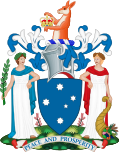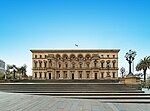Spring Street, Melbourne

Spring Street is a major street in the central business district of Melbourne, Australia. It runs roughly north-south and is the easternmost street in the original 1837 Hoddle Grid.Spring Street is famous as the traditional seat of the Government of Victoria, as well as being central to many of the state's major cultural institutions. The street's name is frequently used as a metonym to refer to the state's bureaucracy. Spring Street is also notable for its impressive Victorian architecture, including Melbourne Parliament House, the Old Treasury Building, the Windsor Hotel (also known as Duchess of Spring Street) and the Princess Theatre. The street is thought to be named after Baron Thomas Spring Rice, Chancellor of the Exchequer under Lord Melbourne. An alternative theory is that the name is due to the golden wattle trees in full bloom during Richard Bourke's visit.
Excerpt from the Wikipedia article Spring Street, Melbourne (License: CC BY-SA 3.0, Authors, Images).Spring Street, Melbourne
Spring Street, Melbourne Melbourne
Geographical coordinates (GPS) Address Website Nearby Places Show on map
Geographical coordinates (GPS)
| Latitude | Longitude |
|---|---|
| N -37.8116 ° | E 144.9732 ° |
Address
Parliament
Spring Street
3000 Melbourne, Melbourne
Victoria, Australia
Open on Google Maps











